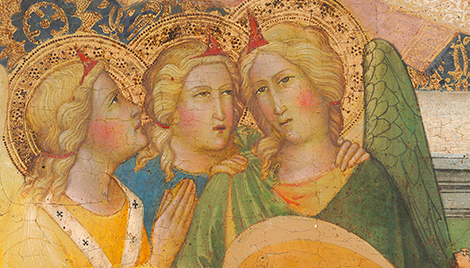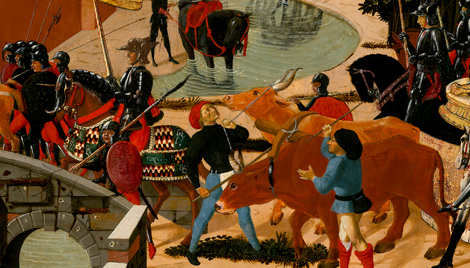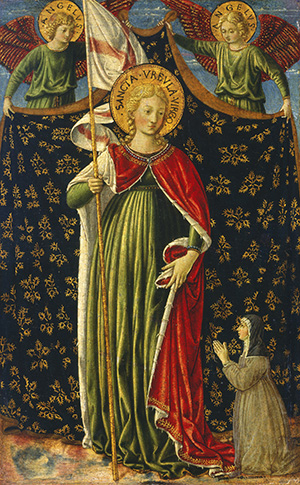Saint Ursula with Two Angels and Donor
Saint Ursula with Two Angels and Donor
- Artist
- Benozzo Gozzoli
- Artist Dates
- c. 1421-1497
- Artist Nationality
- Italian
- Title
- Saint Ursula with Two Angels and Donor
- Date
- c. 1455/1460
- Medium
- tempera on panel
- Dimensions
- 44.5 x 28.5 cm (17 1/2 x 11 1/4 in)
- K Number
- K482
- Repository
- National Gallery of Art
- Accession Number
- 1939.1.265
- Notes
Provenance
Grand Duke Georg II Saxe-Meiningen [1826-1914], who possibly acquired it during the third quarter of the nineteenth century in Florence; [1] by 1900 in his castle at Meiningen, Saxony; [2] sold in the mid- or late 1920s. [3] (Duveen Brothers, Inc., London and New York); sold March 1937 to the Samuel H. Kress Foundation, New York; [4] gift 1939 to NGA. [1] Although it does not appear among the ten early Italian panels described by Max Jordan in the collection of the Duke of Saxe-Meiningen in 1872 (see Joseph Archer Crowe and Giovanni Battista Cavalcaselle, _A New History of Painting in Italy, from the II to the XVI Century_, German ed. trans. Max Jordan, 6 vols. in 8 parts, Leipzig, 1869-1876: 4:592-593), it is likely that at that time the collection had already assumed its definitive aspect. Two of the more important items, the pair of _Saints_ by Perugino now in New York (see Pietro Scarpellini, _Perugino_, Milan, 1984: 114) were still in Florence in 1850, with the dealer Metzger (see Giorgio Vasari, _Le vite de'più eccellenti pittori, scultori e architetti_, ed. Le Monnier, 14 vols., Florence, 1850 (originally 1568): 6:47 n. 2), and it is likely that Johann Metzger and his son, Ludwig, suppliers of early Italian pictures to the Berlin and Munich galleries, also provided paintings of the same kind to Meiningen Castle. On the Metzgers see John Fleming, "Art Dealing in the Risorgimento-II," _The Burlington Magazine_ 121 (1979): 497 n. 2. [2] See Bernard Berenson, _The Florentine Painters of the Renaissance_, 2nd ed., New York and London, 1900: 106. [3] The collection was probably broken up in the 1920s. A triptych by Bernardo Daddi, now in the Frick Art Museum in Pittsburgh (no. 1973.27), was sold in 1920 (see Richard Offner, _A Critical and Historical Corpus of Florentine Painting_, sec. 3, 2nd ed., Florence, 1991: 4:234), and Filippino Lippi's _Adoration of the Child_ (NGA 1937.1.18), left the Saxe-Meiningen collection in 1929. In any case, Gozzoli's panel, recorded by Bernard Berenson, "Quadri senza casa: Il Quattrocento fiorentino. Part 3," _Dedalo_ 12, no. 11 (November 1932): 837, as on the market, obviously must have changed ownership sometime before that date. [4] The Duveen Brothers letter confirming the sale of twenty-four paintings, including NGA 1939.1.265, is dated 9 March 1937; the provenance is given as "Saxe-Meiningen Coll'n" (copy in NGA curatorial files; Box 474, Folder 5, Duveen Brothers Records, accession number 960015, Research Library, Getty Research Institute, Los Angeles).






